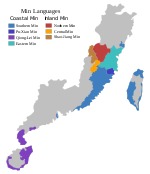Wenchang dialect
| Wenchang | |
|---|---|
| 文昌话 | |
| Native to | Southern China |
| Region | Wenchang, Hainan |
Early forms | |
| Language codes | |
| ISO 639-3 | – |
| Glottolog | None |
| Linguasphere | > 79-AAA-kdb 79-AAA-kd > 79-AAA-kdb |
The Wenchang dialect (simplified Chinese: 文昌话; traditional Chinese: 文昌話; pinyin: Wénchānghuà) is a dialect of Hainanese spoken in Wenchang, a county-level city in the northeast of Hainan, an island province in southern China.
It is considered the prestige form of Hainanese, and is used by the provincial broadcasting media.
Phonology
[edit]The initials of the Wenchang dialect are as follows:[4]
| Bilabial | Dental | Palatal | Velar | Glottal | ||
|---|---|---|---|---|---|---|
| Stop / Affricate | voiceless | t | tɕ | k | ʔ | |
| voiced implosive | ɓ | ɗ | ||||
| voiced | b | d | dʑ | g | ||
| Nasal | m | n | ŋ | |||
| Fricative | voiceless | ɸ | s | ɕ | h | |
| voiced | (w) | (j) | ɦ | |||
| Lateral | l | |||||
The semivowels [w] and [j] are in complementary distribution with [ɦ], and may be treated as allophones of the same phoneme.[5] The voiced stops /d/ and /g/ occur with only about ten words each.[6]
There are five vowels, /i/, /u/, /ɛ/, /ɔ/ and /a/.[7] The high vowels /i/ and /u/ may also occur as medials.[8]
The possible finals are:[9]
| Vocalic codas | Nasal codas | Stop codas | ||||||
|---|---|---|---|---|---|---|---|---|
| a 阿 | ai 爱 | au 后 | am 暗 | an 安 | aŋ 红 | ap 盒 | at 达 | ak 北 |
| ɛ 下 | ei 事 | eiŋ 英 | eik 益 | |||||
| i 皮 | iu 手 | in 新 | ip 邑 | it 必 | ||||
| ia 写 | iau 妖 | iam 念 | iɛn 联 | iaŋ 谁 | iap 狭 | iɛt 捏 | iak 菊 | |
| iɔ 笑 | iom 心 | iɔŋ 用 | iop 涩 | iɔk 育 | ||||
| ɔ 歌 | ɔi 鞋 | ou 侯 | ɔm 栾 | ɔn 春 | ɔŋ 公 | ɔp 合 | ɔt 黜 | ɔk 乐 |
| u 有 | ui 气 | un 轮 | ut 脫 | |||||
| ua 娃 | uai 快 | uan 湾 | uaŋ 广 | uat 挖 | uak 廓 | |||
| ue 话 | ||||||||
| m̩ 毋 | ŋ̍ 嗯 | |||||||
The Wenchang dialect has six tones on isolated syllabes:[10]
| Middle Chinese tone | ||||
|---|---|---|---|---|
| level (píng 平) | rising (shàng 上) | departing (qù 去) | entering (rù 入) | |
| upper (yīn 阴) | 44 | 21ʔ | 11 | 51ʔ |
| lower (yáng 阳) | 33 | 42ʔ | ||
Notes
[edit]References
[edit]- ^ Mei, Tsu-lin (1970), "Tones and prosody in Middle Chinese and the origin of the rising tone", Harvard Journal of Asiatic Studies, 30: 86–110, doi:10.2307/2718766, JSTOR 2718766
- ^ Pulleyblank, Edwin G. (1984), Middle Chinese: A study in Historical Phonology, Vancouver: University of British Columbia Press, p. 3, ISBN 978-0-7748-0192-8
- ^ Hammarström, Harald; Forkel, Robert; Haspelmath, Martin; Bank, Sebastian (2023-07-10). "Glottolog 4.8 - Min". Glottolog. Leipzig: Max Planck Institute for Evolutionary Anthropology. doi:10.5281/zenodo.7398962. Archived from the original on 2023-10-13. Retrieved 2023-10-13.
- ^ Woon (1979a), pp. 66–70.
- ^ Woon (1979a), p. 70.
- ^ Woon (1979a), pp. 69, 70.
- ^ Woon (1979a), p. 73.
- ^ Woon (1979a), pp. 74–75.
- ^ Woon (1979a), pp. 71–75.
- ^ Woon (1979a), pp. 75–81.

